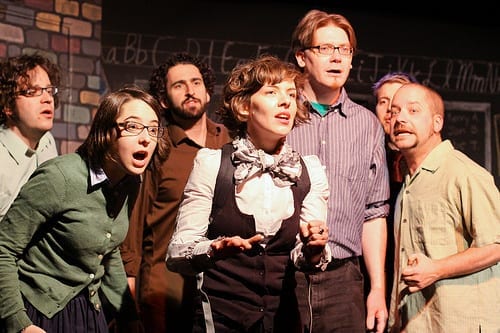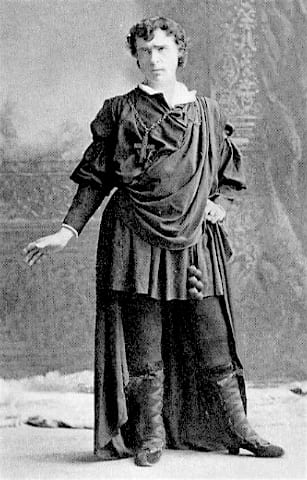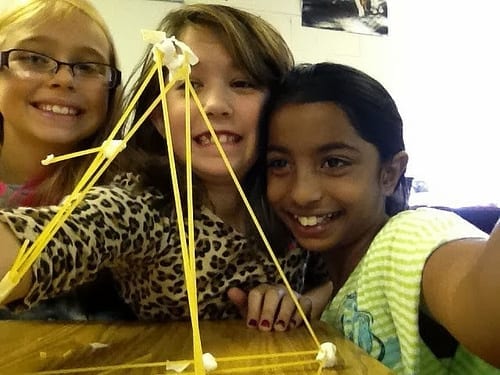The study of improvisation requires the skills that we want our kids to possess
by Katherine McKnight, Ph.D.
 This is why improvisation works in the classroom: To be an improviser (and this is true of improvisers who perform on “Whose Line is it Anyway?” or “Saturday Night Live”) they have very similar skills to what we want kids to see. For example, meaningful study of improvisation requires discipline, collaboration, social interaction, copious practice, critical thinking skills, analytical thinking skills, intuitive thinking skills, and also creative thinking skills. These are the kinds of skills that we want our kids to possess. Improvisation is the ideal pedagogical approach or strategy for teaching and learning due to its inherent structure and flexibility.
This is why improvisation works in the classroom: To be an improviser (and this is true of improvisers who perform on “Whose Line is it Anyway?” or “Saturday Night Live”) they have very similar skills to what we want kids to see. For example, meaningful study of improvisation requires discipline, collaboration, social interaction, copious practice, critical thinking skills, analytical thinking skills, intuitive thinking skills, and also creative thinking skills. These are the kinds of skills that we want our kids to possess. Improvisation is the ideal pedagogical approach or strategy for teaching and learning due to its inherent structure and flexibility.
To begin, building an ensemble and a community is absolutely essential for all improvisers. There are foundational practices that can be applied to your classroom as you start that will also help build classroom community.
Foundational Practice One: Ensemble
Improvisers take this foundational concept seriously. A self-absorbed improviser who tries to control an exercise or game is not viewed favorably. As an improviser, and a member of an ensemble, it is your paramount responsibility to make your partners “look good”. We support each other in an ensemble. Of course, educators recognize this as building a community of learners. When we work together and collaborate, whether it’s an ensemble of improvisers or a class of students, we can create and learn jointly.
Foundational Practice Two: Yes… And
 “Yes, and,” is rooted in the idea that all ideas are embraced. In other words, whatever I bring to the table or suggest is not negated. It’s embraced and from there we build and add to it. If I said to you, “Oh, here’s a notebook” and I hand you an imaginary notebook and you say to me “That’s not a notebook, it’s banana!” you’ve already rejected what I presented and we hit a creative roadblock. In the improv world, this is just taboo. Instead, when I said “Here’s a notebook” and my partner might say “And did you see there’s a hidden note inside?” Now we have something to build on because my partner and I acknowledged the fact that it’s a notebook and there’s something else there. It’s a community and we want to build on each other’s ideas. Similarly, a 21st century classroom should embody, “Yes….and.”
“Yes, and,” is rooted in the idea that all ideas are embraced. In other words, whatever I bring to the table or suggest is not negated. It’s embraced and from there we build and add to it. If I said to you, “Oh, here’s a notebook” and I hand you an imaginary notebook and you say to me “That’s not a notebook, it’s banana!” you’ve already rejected what I presented and we hit a creative roadblock. In the improv world, this is just taboo. Instead, when I said “Here’s a notebook” and my partner might say “And did you see there’s a hidden note inside?” Now we have something to build on because my partner and I acknowledged the fact that it’s a notebook and there’s something else there. It’s a community and we want to build on each other’s ideas. Similarly, a 21st century classroom should embody, “Yes….and.”
Foundational Practice Three: Give and Take
Although many improvisers might disagree with me, I characterize “Give and Take” as a combination of “Ensemble” and “Yes…and.” The concept behind “Give and Take” is that when we are building ideas through improvisation, we respond and take turns. No one monopolizes the attention or discussion. We take turns and build together so no one in the ensemble is excluded. Perhaps in your classroom, you have a few students who blurt out responses and answers and might dominate a discussion. If your students are practicing “Give and Take,” they are taking turns to respond and discuss. I like to think of this as “democratizing attention, focus and air time.”
A Special Foundational Practice for Teachers: There are No Mistakes in Improv!
 I am often asked by colleagues while I am presenting a workshop on improvisation for the classroom, if we should correct and stop students when they make a mistake. My response embodies the following:
I am often asked by colleagues while I am presenting a workshop on improvisation for the classroom, if we should correct and stop students when they make a mistake. My response embodies the following:
- Let’s refrain from “correcting” our students. Improvisation is about exploring and developing fluency in thinking. If students are continually interrupted, they can lose confidence and creativity during improvisational exercises.
- We actually learn from making “mistakes,” not from being correct all the time.
- When students make errors in content information, we would correct. It would be best to do so once the students have completed an improvisational exercise. When doing so, be sure to use a generative prompt like, “What could we add?” or “What should we revise about the content presented?”
What is an Improvisational Exercise and How Does it Connect to the Classroom?
 Each exercise is loosely structured and has a point of focus or a point of concentration. We don’t need to give a lot of rules or tell students what to do. For example, with One Word Story we could say “You’re going to create a story one word at a time” to a group of 8-9 students and that’s the focus. Viola Spolin, the foundational artist of improvisation said “Let the games or let the exercises teach themselves;” kids learn when we create structures in which they can explore and experiment. They can engage in critical thinking to solve a problem which is much of what improvisation is about. Here is a point of concentration (create a One Word Story) and as students are working through that, they may discover all kinds of things like:
Each exercise is loosely structured and has a point of focus or a point of concentration. We don’t need to give a lot of rules or tell students what to do. For example, with One Word Story we could say “You’re going to create a story one word at a time” to a group of 8-9 students and that’s the focus. Viola Spolin, the foundational artist of improvisation said “Let the games or let the exercises teach themselves;” kids learn when we create structures in which they can explore and experiment. They can engage in critical thinking to solve a problem which is much of what improvisation is about. Here is a point of concentration (create a One Word Story) and as students are working through that, they may discover all kinds of things like:
- how a word can shift a story
- how syntax and semantics really impact the development of a text
- how to work with each other
- how to listen to each other
Additionally, sequencing, predicting, reflecting and high levels of comprehension are part of a seemingly simple exercise of creating a story one word at a time.
 One Word Story has curriculum applications other than as a prewriting activity for a narrative story. This improvisational game can be used as a summarization activity of an informational text. A math problem can be solved step-by-step, using One Word Story. Begin with the problem and the students solve it, one word at a time. One Word Story is an effective exercise for summarization, sequencing and checking for student understanding. For more improv games and lesson plans see my co-authored book, The Second City Guide to Improv in the Classroom.
One Word Story has curriculum applications other than as a prewriting activity for a narrative story. This improvisational game can be used as a summarization activity of an informational text. A math problem can be solved step-by-step, using One Word Story. Begin with the problem and the students solve it, one word at a time. One Word Story is an effective exercise for summarization, sequencing and checking for student understanding. For more improv games and lesson plans see my co-authored book, The Second City Guide to Improv in the Classroom.
This is the genius of improvisation. At first, it may seem that it’s a bunch of simple exercises but there’s complexity that becomes a catalyst for critical thinking. Imagine your classroom that embodies a “Yes….and” mindset.
Author
She regularly publishes in professional journals and is the author of many award-winning, professional books. Dr. McKnight is also a graduate of the Second City Conservatory Improv program in Chicago. Dr. McKnight’s work on using improvisation in the classroom has taken her to many schools and has worked with Chicago Shakespeare Theater and EF Explore America. To learn more about Dr. McKnight, visit her website www.KatherineMcKnight.com. You can also find her work at MyEdExpert.
Further Reading
- Huffington Post – The Top 15 Traits Educators Need To Teach Successfully Online
- Faculty Focus – Improv in the Classroom
- UM-Flint – UM-Flint Faculty Members Research Improvisation in the Classroom
